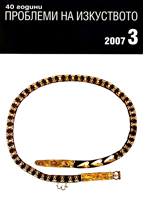Ритон из Астраханской области
A Ceramic Rhyton from the Samosdelka Fortified Site in the Astrakhan’ Region
Author(s): Emma D. ZilivinskayaSubject(s): Cultural history
Published by: Институт за изследване на изкуствата, Българска академия на науките
Summary/Abstract: Among archaeological sites found along the Lower Volga, Samosdelka holds a unique place, since the study of this site to a large extent changed our understanding of the historical development of this region. Until recently it was thought that towns appeared in the territory of the Lower Volga only at the beginning of the time of the Golden Horde in the 13th-14th centuries. Data from written sources was supported by exceptionally scarce archeological material. Similarly, the city of Saksin from the 12th century was also not able to be located, even though it is also known from written sources. As a result of archeological excavations it has become clear that Samosdelka appeared during the 11th c. and existed continuously until the 1430 s. Its core population was made up for Bulgars and Togoz who had emigrated there from the lower Syrdarya River. The ceramics from Samosdelka are striking in their abundance and variety of forms. One extremely interesting vessel, a ceramic rhyton, has been found. In its morphology the rhyton from Samosdelka is closest to the vessels of Type I from Fergana (according to G. Al Brykina). Similar vessels have also been found at the Tashkent oasis, as well as in Rea and Afghanistan. Despite this similarity, however, the Samosdelka rhyton has a number of distinguishing characteristics that make it possible to suggest that it has local origins. Most likely it originated in the layers from the 9th-10th centuries, since similar vessels from later times have not been found. It is also of interest due to the fact that it is the second ceramic rhyton found in Eastern Europe.
Journal: Проблеми на изкуството
- Issue Year: 2007
- Issue No: 3
- Page Range: 26-31
- Page Count: 6
- Content File-PDF

